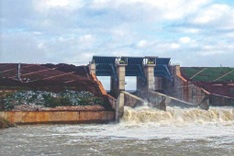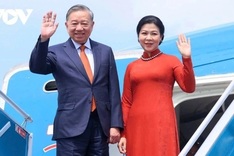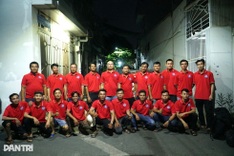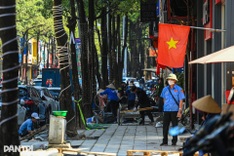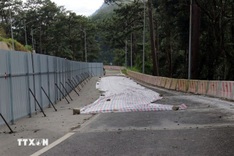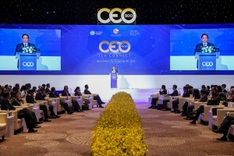 |
| Revisions to the rules on foreign investment in education will allow more foreign players into this expanding market |
In response to recommendations made by foreign investors, the Ministry of Education and Training (MoET) is revising several regulations on foreign investment and co-operation projects in the education and vocational training sector.
Pham Chi Cuong, deputy head of the ministry’s International Co-operation Department, told VIR that “The revision is focusing on the limitation on the percentage of Vietnamese students, licensing-related issues, and the legal framework to extend the operation terms of educational institutions.”
This move demonstrates the MoET’s determination to improve the business climate in the field and help to clear significant barriers to entry for foreigners wishing to invest in higher education in Vietnam. In fact, obstacles in the country’s education policies are among the main reasons that deter foreign direct investment (FDI) in the sector over recent years. Education remains in the bottom tier of sectors that receive foreign investment. As reported by the Ministry of Planning and Investment’s Foreign Investment Agency (FIA), as of June 13, 2016, Vietnam attracted over $735.84 million in FDI via 276 projects in the education and training sector. The US topped the list with $179.3 million, followed by Japan with $98.37 million, and Singapore $80.42 million. Taking this into consideration, education is still ranked 17th among the 18 sectors receiving FDI in Vietnam.
Challenges remain
The complexity of many existing regulations on education investment has been fiercely discussed at business workshops and forums since 2012. At this time, Decree No.73/2012/ND-CP took effect in November 2012, governing FDI and co-operation projects in the education and vocational training sector in Vietnam.
During a conference titled “Hanoi 2016 - Investment and Development Co-operation” held early this month, these issues were once again raised when Christopher Jeffery, vice chairman of British Business Group Vietnam, said that licensing, facilities, and the development of new programmes were the three key issues that Vietnam should focus on.
“In order to exist, foreign institutions are required to obtain three licences. Although these processes are similar, they must be pursued independently and sequentially. This can be quite a challenge. Additionally, Decree 73 is ambiguous, resulting in varied interpretations which often contradict one another,” Jeffery stated.
The other concern is the development of new programmes that would fit the Vietnamese and/or international model. Again, the issue at hand is a slow process made even more complicated by sometimes ambiguous and inconsistent interpretations. This results in fewer options for students, which in turn makes recruitment more difficult and investment less attractive. The ultimate outcome is fewer well-rounded, qualified graduates. Jeffery believes it is critical to offer a diverse range of disciplines.
According to Jeffery, one of the greatest contributions that foreign institutions can offer is the development of world-class facilities that attract students who would otherwise consider studying abroad to instead stay at home. This would provide them with the incentive to enjoy the same experience at a fraction of the cost, while maintaining cultural and family ties. The support of the central and Hanoi government in land allocation to foreign investors for development of world-class facilities is a pre-requisite for development of the sector, both in direct investment projects such as British University Vietnam (BUV) and public private partnership (PPP) projects.
Brian O’Reilly, head of the Vietnam Business Forum’s (VBF) Education and Training Working Group, complained that the cap of 10 to 20 per cent of Vietnamese students allowed to join international schools is unreasonable because the demand of Vietnamese students in international schools is rapidly increasing.
“With the present limitation, the foreign investment in education is closed in second-tier cities of Vietnam because the enrolment percentage of 10 to 20 per cent of Vietnamese students allowed to join international schools is based on the number of foreign enrolled students. The fact is, almost all second-tier provinces besides Hanoi and Ho Chi Minh City have a very limited number of foreign enrolled students. As a result, a very limited number of Vietnamese students are allowed to attend,” he added.
The other unsolved issues include limited invested capital, the inspection of facilities of foreign-invested institutions, the lack of a legal framework to extend the operational terms of educational institutions, and high requirements for teaching staff.
A promising land
Statistics from the FIA showed that Ho Chi Minh City continued to be the most attractive destination for education investors, with 128 projects worth $267.7 million. The runners-up were Hanoi with 102 projects worth $215.5 million and Danang with 11 projects valued at $158.11 million.
Over past years, many foreign investors have succeeded in education investments in Vietnam. One of the most successful is Singapore’s KinderWorld Education Group. The other big brands are American Pacific University’s $150 million project in Danang, BUV’s $70 million project in Hung Yen province, and the $68.9 million Nagai Vietnam Centre and Oasis Development Management’s project in Hanoi.
The country has also welcomed brands from the UK, the US, Japan, Australia, and Germany. This also includes South Korea’s Chungdahm Learning, which signed a co-operation agreement with Egroup last week to invest $10 million in creating English learning products in Vietnam.
“Investing in education is not a business to make huge profits but a labour of passion. It is a commitment to excellence and to the future. What we really need is an opportunity to come together and go into greater detail of Decree 73 as partners, with a shared vision for opportunity creation and educational excellence,” Jeffery noted.
For now, the efforts and actions should be made by the Vietnamese government, especially the MoET to unblock capital flows into the education and training sector.
 Ongoing investment in education and training is key for Vietnam’s future prosperity, and in this context a greater focus on skills-based learning will be critical. International partners like New Zealand can assist in meeting the growing demand for education in Vietnam, through the delivery of high quality education services in New Zealand or here in Vietnam. I think both models of delivery (onshore and offshore) are interesting, and we expect there will be plenty of opportunities for foreign institutions and companies to assist in meeting the needs of Vietnam’s education sector. But for this to occur, it will be important that there is clarity and stability in the rules governing foreign investment in the sector. The New Zealand-Vietnam education relationship will continue to flourish. We will continue to see a mix of commitments, with new investment and engagement by New Zealand providers in Vietnam. |
 With a strong commitment with WTO on opening door widely for the education sector, I believe that there are many attractive opportunities for foreign investors to get benefits on providing education and vocational training services in Vietnam. Why? Vietnam now is lacking of international standard education environment while its young labour force is shortage of professional skills and knowledge to exploit effectively their abilities and productivity. However business in education also takes many risks. It requires investors researching the market carefully to create long-term project instead of making money only. Vietnamese people is always appreciated the loyalty so foreign investors should build straightforward strategies and policies for each steps as well as find out experienced local partners to do their business sustainably and safely. For such businesses as our Growth Catalyst Vietnam focusing on developing the education and training sector, we see obviously the potential, opportunities and the risks. Throughout our international study programmes and our foreign experts, we appreciate the true value of foreign partners. |
 Vietnam is a high potential market for investors wishing to invest in education thanks to its young population and increasing demand. Vietnamese parents pay special attention to education to make sure that their children have best possible experience and opportunities. The policy on foreign investment attraction in education is very important as it determines how the sector develops and how attractive it is. It also directly impacts how quickly Vietnam will become a hub for education in the region. However, investors are still encountering challenges due to some regulations in Decree 73. For British University Vietnam, the provisions on licensing and the introduction of new programmes can be challenging and time-consuming. We look forward to continued partnership with the government on improving this situation and creating an attractive environment for educational investors. |
 Vietnam is a very promising education market. Here, the demand of Vietnamese students for international education programmes is increasing all the time. Each year, Vietnamese people are spending about $3 billion on education overseas. Vietnam Australia International School (VAS) has opened some campuses in Ho Chi Minh City, and is planning to open the Garden Hills Mega Campus in Go Vap district in July 2016 to capitalise on this trend. The Vietnamese economy continues to grow apace, and in order to sustain this growth at desired levels amid increasingly deeper global integration, there is an imperative need for quality education. This will be best achieved through a co-ordinated effort by foreign-invested educational institutions. Equipped with the most modern equipment and staffed with qualified and experienced educators, VAS’ campuses will make a significant contribution to increasing training quality in Vietnam, thus helping improve its workforce’s productivity. |





